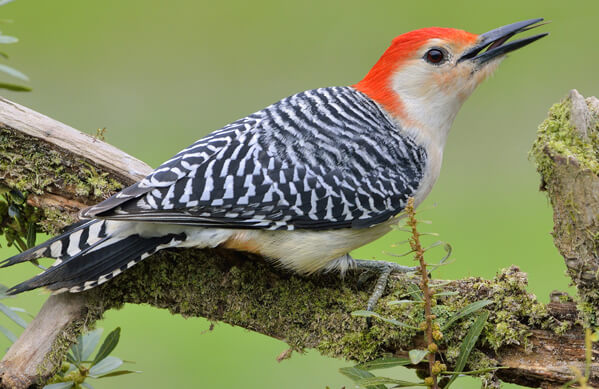Woodpeckers Unleashed: Checking Out the Wonders of These Knowledgeable Tree Mountain Climbers
Woodpeckers, with their unique markings and rhythmic drumming resembling through wooded locations, hold a special place in the bird world. Their specialized makeup and adaptations allow them to navigate vertical surface areas with unmatched ability. Their mastery of tree climbing is simply one element of their fascinating habits. As we look into the detailed information of woodpeckers' nesting behaviors, feeding strategies, and the recurring preservation efforts to protect these amazing birds, a deeper admiration for their location in nature unravels.
Composition and Adaptations
When taking a look at the composition and adaptations of woodpeckers, one can observe remarkable attributes that enable these birds to grow in their specialized eco-friendly niche. Additionally, woodpeckers have zygodactyl feet, with 2 toes encountering onward and 2 dealing with backwards, providing a company grasp on tree trunks while they browse for food or drum for communication.
Moreover, woodpeckers have an unique tongue framework that is long, barbed, and sticky, enabling them to extract pests from gaps in wood. This customized adaptation allows woodpeckers to manipulate a food source that is inaccessible to several other bird species. On the whole, the composition and adaptations of woodpeckers display the amazing transformative remedies that have permitted these birds to prosper in their arboreal habitat.
Drumming Habits
Having checked out the anatomy and adjustments of woodpeckers, the focus currently moves to understanding their drumming actions, a distinctive facet of their communication and territorial display screens. Drumming is an important kind of communication amongst woodpeckers, serving numerous functions such as developing areas, bring in companions, and signaling alarm. Each woodpecker types has a distinct drumming pattern that aids individuals identify members of their very own species and identify them from competitors or predators.
Woodpeckers generate drumming sounds by swiftly pecking on resonant surfaces such as dead trees, energy posts, or perhaps steel things, producing a collection of rhythmic beats. The intensity and rate of drumming can vary based on the purpose; for circumstances, a rapid drumming sequence might represent aggression in the direction of intruders, while a slower and softer drumming pattern could suggest courtship (Woodpeckers in Florida). Furthermore, woodpeckers might readjust the frequency and period of their drumming to share specific messages successfully
Nesting Behaviors
Checking out the nesting behaviors of woodpeckers reveals fascinating insights into their reproductive habits and environment choices. Woodpeckers are known for their distinct nesting choices, often excavating dental caries in trees to create sheltered spaces for increasing their young. These cavities serve not just as a nesting site but additionally as a safe and secure haven from predators and inclement weather.
Woodpeckers exhibit a high level of fidelity to their nesting sites, frequently returning to the same location year after year. This actions highlights the importance of suitable environment schedule for their reproductive success. The option of a nesting website is vital for woodpeckers, with aspects such as tree types, height, and decay phase playing substantial duties in their decision-making process.
Interestingly, some woodpecker species are known to dig deep into several tooth cavities within their territory, providing themselves with different nesting alternatives. This approach might work as a form of insurance against possible hazards or disruptions to their primary nesting website.

Feeding Methods
Woodpeckers use a variety of specialized feeding methods to acquire their key food sources. One of the most unique feeding actions of woodpeckers is drumming, which includes quick pecking on trees to reveal insects beneath pop over to these guys the bark. This drumming not only assists them find target yet additionally acts as a means of communication with other woodpeckers. Woodpeckers have strong, chisel-like beaks that enable them to drill right into timber easily. As soon as an opening is developed, they utilize their lengthy, barbed tongues to remove pests such as ants, beetles, larvae, and crawlers. These tongues are covered with sticky saliva that helps catch the prey. Woodpeckers are also known to excavate cavities in trees to access covert insect larvae or sap. Some types, like the acorn woodpecker, store nuts in specifically produced holes called granaries. This tactical storing of food helps them make it through during food scarcity periods. Woodpeckers are absolutely amazing in their feeding methods, showcasing versatility and intelligence in obtaining their nourishment.
Preservation Initiatives
In the middle of the elaborate feeding techniques showed by woodpeckers, the preservation efforts intended at guarding these interesting birds play an essential role in maintaining their habitats and populaces. Woodpeckers deal with different threats to their survival, consisting of environment loss because of deforestation, environment modification great site modifying their ecosystems, and crashes with manufactured structures such as buildings and automobiles - Woodpeckers in Florida. Guardians are actively functioning to attend to these obstacles and ensure the lasting wellness of woodpecker varieties

Education and learning and public understanding projects are likewise important parts of woodpecker preservation efforts. By elevating understanding about the importance of these birds in keeping healthy woodland environments, guardians can gather assistance for habitat conservation efforts and promote accountable land monitoring techniques. With collaborative initiatives between scientists, policymakers, and local neighborhoods, we can collaborate to secure a future where woodpeckers prosper in their natural environments.
Verdict
